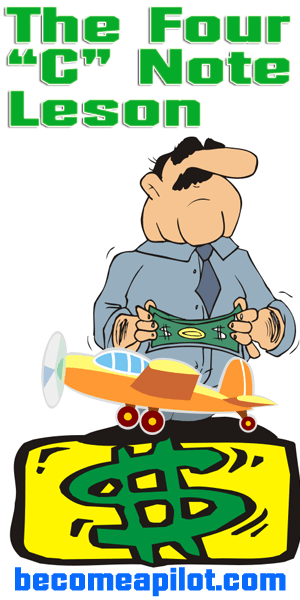 A friend recently took his first flight lesson at a Midwest flight school and paid $400 for 1.2 hours of dual instruction. Shocked? That’s what it cost him for a two-hour block of time (at $100 per hour for the instructor) using a glass-equipped Cessna 172 (at $170 per hour). Cha-ching!
A friend recently took his first flight lesson at a Midwest flight school and paid $400 for 1.2 hours of dual instruction. Shocked? That’s what it cost him for a two-hour block of time (at $100 per hour for the instructor) using a glass-equipped Cessna 172 (at $170 per hour). Cha-ching!
Sure, there are places to find less expensive flight training. Even at lower relative costs, flight training might still be unaffordable for the average Joe or Josephine. This point is especially relevant for the “high school” Joe whose minimal flight training income is dependent on a lawn maintenance business that goes dormant in the winter—a real “sod” story. Aside from the obvious ways of reducing the cost of flight training, I’d like to offer a recommendation that you’ve probably never heard before. Are you ready for it?
If you want to learn to fly on a budget, then learn to fly before you learn to fly.
Given the fidelity of today’s flight simulation software, the average person can acquire highly sophisticated flying skills using inexpensive software and a simple desktop computer. I know this for a fact given my experience with students who’ve operated Microsoft Flight Simulator over the years. It’s not just my opinion either. Over the past decade, many students and instructors have testified to the power of desktop flight simulation in reducing the cost of flight training. The time has come to take flight simulation to the next level and make flight training more affordable for everyone. Let’s begin with the hardware.
Your first purchase should be Microsoft Flight Simulator, version X (preferably). You’ll also need a joystick and rudder pedals. Find discount deals by shopping for used hardware on eBay.
Next, you’ll need a minimum of two books and two pamphlets. Your first purchase should be a book that will give you the intimate details of simulator operations. Without a doubt, one of the best on the market is Bruce Williams’s Scenario-Based Training with X-Plane and Microsoft Flight Simulator. You’ll also need a book with detailed step-by-step instructions on how to fly an airplane. The book should cover the four fundamentals of flight, slow flight, stalls, spins, and landings as well as the other requirements for a private pilot certificate (please check out my newest book titled, Rod Machado's How to Fly an Airplane Handbook on this site. Search around and ask for a recommendation on a good book having this content. Finally, download the FAA’s free Private Pilot Practical Test Standards and a good private pilot flight training syllabus (both are available for free via Google search). Got all that? Good. Here’s where you’ll get down to serious study.
Begin by taking the ground and flight lessons in Microsoft Flight Simulator. Read the individual chapters of both books between lessons. Use your big brain here. Learn as much as you can from the simulator and your reading materials. Then do what Bigfoot does and take the next big step.
Visit the local flight school, chat with the instructors, find one you like, wrap him up, and take him home. Better yet, invite this person to your home for an hour’s worth of dual flight training on your simulator. In addition to his or her hourly fee, a promise of free desserts with moist dairy toppings will entice most instructors to make a house call.
When he arrives, have him explain the syllabus and Practical Test Standards to you. (Whatever you do, don’t say, “Explain your PTS to me.” Otherwise, he might drone on for hours about his posttraumatic stress caused by students who can’t land.)
Now it’s time to take your first official dual flying lesson on your simulator with your new instructor. At this point, don’t plan on flying the real airplane until you’ve practiced and mastered every flight maneuver in the Practical Test Standards. Given that there are 12 sections in the Practical Test Standards, you should plan on at least 12 in-house flight lessons with your new instructor. Take more if you want. This is money well spent.
I realize that there are limitations to this approach, but the fact is that flight simulation is already used by major flight schools to accelerate and enhance student learning. Students who follow this strategy—and dedicate themselves to the book work—will substantially reduce the cost of earning a private pilot certificate. Your biggest challenge will be to maintain a fresh supply of most dairy toppings to ensure your instructor’s happiness (and reduce his PTS).
